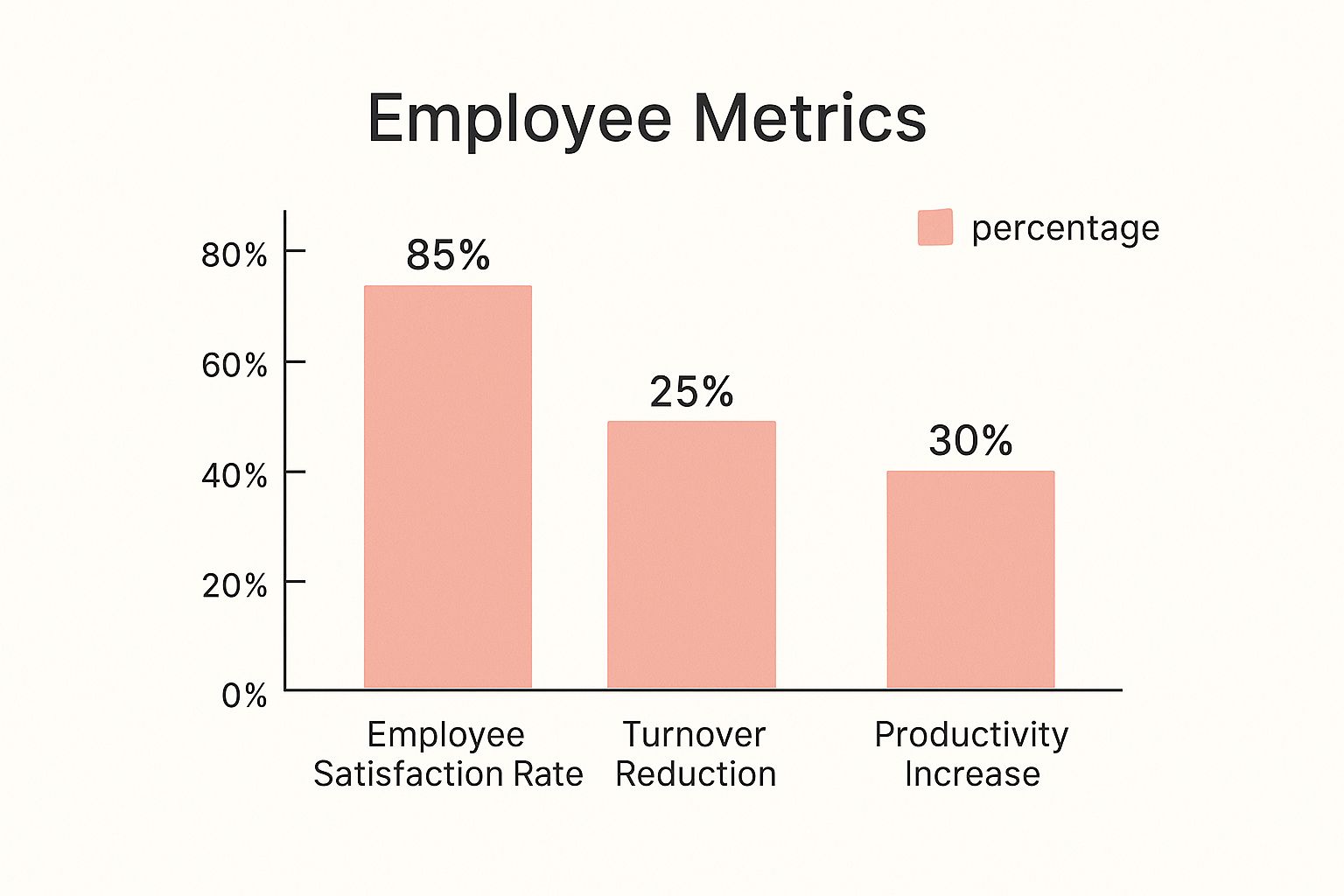Creating a positive work environment is more than just offering free snacks or installing a ping-pong table. It's about architecting a culture built on the powerful foundations of trust, open communication, and a shared sense of purpose. When you achieve this, you unlock a space where people feel genuinely valued, respected, and inspired to bring their best selves to work every single day.
The Blueprint for a Thriving Workplace
Imagine a workplace buzzing with creative energy, where every single person feels aligned, motivated, and part of something bigger. This isn't a fantasy; it's the tangible result of a culture that puts its people first. To build this, you must focus on what truly matters: psychological safety, genuine respect, and a unified vision.
A magnetic culture is no longer a "nice-to-have"—it's a critical business advantage. A landmark study from the University of Oxford’s Saïd Business School found that happy workers are 13% more productive. When people feel secure enough to take risks and supported enough to collaborate freely, innovation doesn't just happen; it flourishes.
This visual breaks down the powerful outcomes of a positive work environment, highlighting major improvements in satisfaction, retention, and productivity.

The numbers don't lie. A thriving culture directly builds a more stable, engaged, and effective team.
What Really Drives Job Satisfaction?
It's a common myth that a bigger paycheck is the ultimate key to workplace happiness. While fair compensation is essential, research reveals a more profound truth. A study published in the Journal of Vocational Behavior found that while salary is important, factors like autonomy and social support are significantly stronger predictors of job satisfaction. What truly makes a difference is the day-to-day experience—the culture and the human connections.
Think about it: 88% of employees say that having positive relationships with their colleagues is a major boost to their job satisfaction. And 86% feel the same way about having a healthy relationship with their manager.
This is a powerful signal for leaders. Investing in human connection and a supportive atmosphere delivers a much higher return than focusing on pay alone.
Core Pillars of a Positive Work Environment
| Pillar | Actionable Focus | Impact on Culture |
|---|---|---|
| Psychological Safety | Create a space where people can speak up, share ideas, and admit mistakes without fear of punishment or humiliation. | Fosters innovation, encourages honest feedback, and builds deep-seated trust among team members. |
| Open Communication | Promote transparency from leadership and encourage clear, respectful dialogue across all levels of the organization. | Reduces misunderstandings, aligns everyone on shared goals, and makes people feel heard and valued. |
| Recognition & Growth | Acknowledge contributions consistently and provide clear pathways for professional and personal development. | Boosts morale and motivation, shows employees they have a future with the company, and improves retention. |
| Work-Life Balance | Actively support employees' well-being by respecting their time outside of work and offering genuine flexibility. | Prevents burnout, increases productivity and focus during work hours, and shows that the company cares. |
These pillars are the bedrock of a workplace that doesn't just succeed, but truly inspires.
For a deeper dive, check out this an essential guide on how to improve workplace culture. It's the perfect starting point for building a workplace that people love.
Foster Fearless Communication and Open Dialogue
A positive culture is built on conversations, not commands. It comes alive when your team feels safe enough to share bold ideas, question the status quo, and even admit to mistakes without fear. This feeling of psychological safety, a concept championed by Harvard Business School professor Amy Edmondson, is the true engine of trust and innovation.
When people can speak freely, you unlock a powerful stream of creative solutions and honest feedback. This isn't just about avoiding problems; it's about actively welcoming diverse perspectives to make the entire team stronger and more resilient.

Make Every Interaction Count
Transforming everyday communication into a tool for growth requires intention. It starts with leaders modeling the behavior they want to see, creating space for everyone to contribute, and listening more than they speak.
To build a truly open environment, explore practical ways for how to improve team communication. The goal is to make every conversation—from a quick one-on-one to a major team meeting—an opportunity to build trust.
Action Points to Spark Open Dialogue:
- Run "Round Robin" Brainstorms: Instead of a free-for-all, go around the table and give each person uninterrupted time to share. This simple technique prevents louder voices from dominating and ensures every perspective is heard.
- Practice Active Listening: When a team member is speaking, make your goal to understand, not just to reply. A powerful method is paraphrasing: "So, what I'm hearing is..." This confirms you're on the same page and shows you're fully engaged.
- Hold "No-Blame" Retrospectives: After a project, focus the conversation on the process, not the people. Ask questions like, "What can we learn?" or "How can we improve next time?" instead of pointing fingers.
For distributed teams, creating connection is just as vital. Find more inspiration in our guide to team-building activities for remote workers that foster great communication from anywhere.
The quality of your work environment is directly proportional to the quality of your conversations. Make them count.
Empower Your Team with Trust and Autonomy
Nothing crushes creativity and drive faster than micromanagement. To build a positive, thriving work environment, you must shift your mindset from control to empowerment. This means cultivating a culture of deep trust and giving your team genuine autonomy over their work.
When you delegate tasks that foster growth, set crystal-clear expectations, and then step back, something incredible happens. People take true ownership. They begin to think like proactive problem-solvers who are personally invested in the outcome, not just cogs in a machine.

This approach taps directly into what motivates people at their core. Recent data shows employee job satisfaction is hitting all-time highs, driven not just by paychecks but by the quality of the workplace culture. The most powerful drivers of satisfaction are things like genuine interest in the work, quality leadership, and having control over one's projects—all rooted in trust. You can learn more about these job satisfaction findings for yourself.
Cultivating Ownership and Confidence
Granting autonomy doesn't mean disappearing. It’s about finding the balance between guidance and independence, acting more like a coach than a commander. Your role is to provide the resources and support your team needs to achieve greatness on their own terms.
Action Points to Build Empowerment:
- Define the "What," Not the "How": Align everyone on the desired outcome and project goals. Then, empower your team to determine the best path to get there. This shows you trust their expertise and respect their problem-solving skills.
- Encourage Calculated Risks: Create a space where it's safe to innovate, even if it doesn't work out perfectly. Frame failures as valuable learning opportunities, building resilience and encouraging creativity.
- Delegate for Development: When assigning a task, think about who would grow the most from the opportunity. Match projects to their individual strengths and career goals to show you're invested in their journey.
Empowerment is giving people the space to be brilliant. Trust is the air that space needs to exist.
By letting go of rigid control and fully embracing trust, you’ll cultivate a team of confident, engaged individuals who feel a true sense of purpose in their work.
Champion Meaningful Growth and Recognition
Humans are wired with a fundamental need to learn, grow, and feel appreciated. A truly positive workplace doesn't just acknowledge this—it actively nurtures it. This goes far beyond an annual review or a generic "good job." It’s about investing in your people's futures and making appreciation a daily practice.
When your team members see a clear path forward, their engagement and motivation skyrocket. This isn’t just about promotions; it's about opportunities to master new skills, take on exciting projects, and broaden their expertise. This commitment sends a powerful message: you see their potential, not just their current output.

Weave Recognition into Your Daily Culture
Recognition is most powerful when it’s frequent, specific, and sincere. A timely, heartfelt "thank you" for a specific action can mean far more than a formal award months later. The goal is to create a culture where appreciation is simply how you operate.
Action Points for Impactful Recognition:
- Kick off meetings with wins: Before diving into the agenda, take two minutes to go around and ask everyone to share a recent success or shout out a colleague who helped them.
- Get hyper-specific with praise: Instead of a generic "good job," try something like, "I was so impressed with how you handled that client's difficult question. Your calm and knowledgeable response saved the situation." Details show you’re truly paying attention.
- Encourage peer-to-peer shout-outs: Set up a dedicated space—like a Slack channel or a spot on a team bulletin board—where anyone can publicly thank a teammate. This builds incredible camaraderie and reinforces a collaborative spirit.
Genuine recognition is a powerful currency. It costs nothing but delivers a massive return in motivation, loyalty, and performance.
By championing both growth and recognition, you spark a self-reinforcing cycle of positivity. Employees who feel seen and valued are more motivated to learn, and as they develop new skills, they create even more opportunities for meaningful recognition.
Design a Workspace That Inspires Well-Being
Our physical space has a profound impact on our mood, energy, and creativity. A thoughtfully designed workspace—whether in an office or at home—is a powerful tool for building a positive environment. It sends a clear message that you care about your team’s well-being.It’s not about expensive furniture; it’s about creating a human-centric space that supports focus, collaboration, and calm.
The link between a great workspace and happy employees is stronger than ever. A major workplace survey found that people in inspiring environments are nearly three times more likely to stick with their company and report higher engagement. You can discover more insights from Gensler's Global Workplace Survey to see how physical space shapes culture.
Small Changes, Big Impact
You don’t need a massive budget to make a real difference. A few intentional adjustments can transform how your team feels at work.
Action Points for an Inspiring Workspace:
- Embrace natural light: Position desks near windows whenever possible. Natural light is a proven mood-booster and helps reduce eye strain.
- Go green with biophilic design: Adding low-maintenance plants can purify the air, lower stress, and improve concentration, according to studies in the Journal of Physiological Anthropology. It’s a simple touch that brings life into the office.
- Create flexible zones: Design different areas for different needs: a quiet corner for deep focus, a comfy lounge for casual chats, and ergonomic workstations to create a dynamic and supportive atmosphere.
Your workspace is a living part of your culture. Make it a place that rejuvenates, not drains, your team’s energy.
By focusing on these details, you’re actively crafting a culture of positivity. To dive deeper, check out our guide on designing a workspace that serenades your senses.
Your Questions About Workplace Culture Answered
Building a positive workplace is an ongoing journey, not a destination. As you put these ideas into practice, questions will arise. That’s a great sign! It means you’re paying attention.
Here are a few common questions, along with real-world advice to keep the positive energy flowing.
How Can I Tell If Our Work Environment Is Actually Improving?
You can measure your culture by looking at both hard data and subtle, everyday interactions.
Anonymous pulse surveys are a great starting point. Ask direct questions about psychological safety, feeling valued, and communication clarity. This gives you a solid baseline to measure against.
Also, track metrics like employee turnover and absenteeism. When people are happier and more engaged, they’re far more likely to stay. A dip in these numbers is a fantastic sign that you’re on the right track.
But the data only tells half the story. The real magic is in the small moments.
Are people laughing more? Are meetings more creative and collaborative? When you start hearing team members give each other unsolicited praise, you know you’ve struck gold. That’s what a thriving culture looks and feels like.
What Can I Do Right Now With Little to No Budget?
You don’t need a huge budget to make a meaningful difference. In fact, some of the most powerful actions cost nothing at all.
Start by making recognition a daily habit. A specific, genuine "thank you" for a job well done—whether in a team meeting or a private message—can change someone's day. Be sure to connect their contribution back to the team's bigger goals.
Audit your meeting culture. Could it be better? Kick off meetings with a quick win or a shout-out to a colleague. Make a conscious effort to ensure everyone has a chance to speak. It’s a small shift that transforms the energy in the room.
And perhaps the most powerful tool you have? Simply ask your team: "What is one thing we could change to make your work life better?" Listen with the intent to understand, then show them they were heard by taking action.
How Do We Keep the Vibe Positive During a Really Stressful Project?
This is where great leadership shines. When pressure mounts, your team looks to you to set the tone.
First, acknowledge the stress. Don’t pretend it isn’t there. Being transparent about challenges builds incredible trust and shows your team you’re in it with them.
Next, be ruthless about protecting your team from burnout. This might mean pushing back a non-essential deadline or simplifying a project's scope. During these times, double down on recognizing effort and resilience, not just the final result.
Lead by example. Stay calm, supportive, and keep your sense of humor. Celebrating small wins along the way is a powerful morale booster that reminds everyone of their collective strength and that, together, you’ll get through it.
At Mesmos, we believe that fostering positivity starts with small, intentional acts of kindness and mindfulness. Explore our collection of thoughtful gifts and stationery designed to inspire a more beautiful and significant everyday life. Discover how a meaningful gift can brighten a coworker's day and strengthen your team's bonds at https://mesmos.co.
